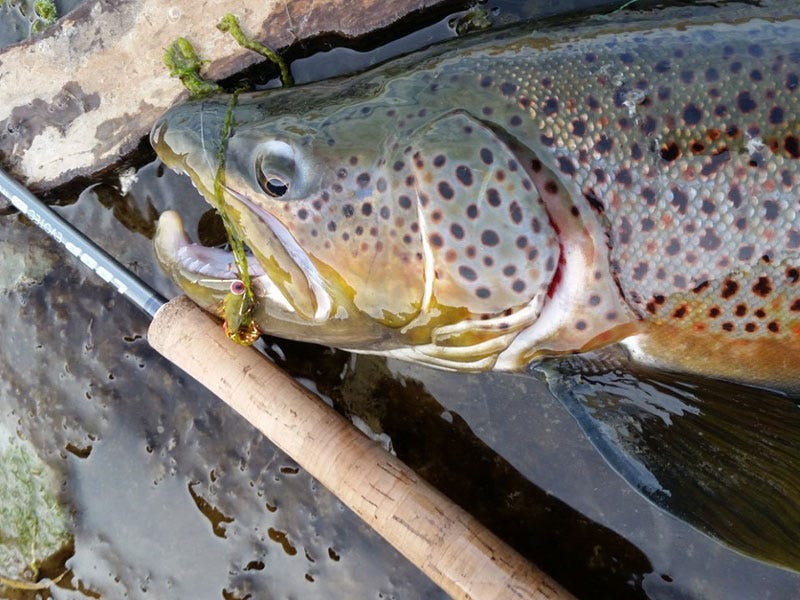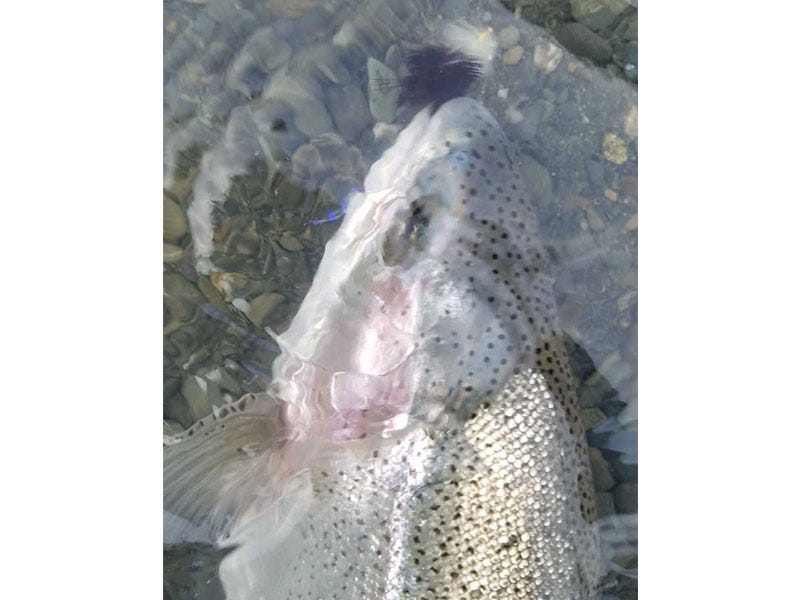Streamer Time

Late fall is streamer time. Hatches have become limited to midges and baetis, so hungry fish have little distraction when presented with a meal in the form of a juicy streamer. Weeds have started clearing away, so you can present that streamer without constant fouling. But what to choose?
A bigger fish is always better. Check out our go-to patterns for large fish here.
Size Matters
If you want to tempt a hungry brown, big articulated flies will often get results. After the spawn, browns are hungry and they will attack flies that represent a small fish and a big meal. A 4 to 6-inch fly is not too big for an 18 to 22-inch fish. The larger ones, we are always chasing, are more likely to react to a big meal. The thing is, there are not as many large browns as there are rainbows and smaller browns. If you fish the big flies, you will sacrifice some quantity in the hunt for those particular chosen fish.
If you want to catch more fish, 1.5 to 2.5-inch streamers will often provide the most consistent action. There are some predatory rainbows that will whack a big fly, but most spend their time eating lots of smaller bites. Browns will also eat small streamers when they find them easy to catch. Flies representing small minnows are almost always on the menu for trout, especially when insect hatches are minimal.
Color Matters
If you look at the streamer section in your local fly shop, you will see a wide color palette represented. Some flies are multi-colored. Some flies are mostly solid black or white. Some flies have a little or a lot of flash. All of them can work, some of the time. The key is to have several choices from light to dark and flashy to neutral. Some days you can pick one and it’s game on. Other times, you will have to work through several choices until you find the winner.
Want to increase your odds of catching a trophy-sized trout? Read about big streamer flies here.
Speed and Motion
Large flies generally need a bit of speed to provoke strikes. If a meal is big enough, it’s worth a chase. A predatory fish has a hard time ignoring a moving but catchable target. Big flies that move quickly, then pause and wiggle seductively and then burst into motion again, are hard to resist when fish are hungry and aggressive.
Conversely, smaller flies typically work better when they are easier to catch. Sometimes fish are so switched on that they seem to take almost anything. Most of the time though, fish want a relatively easy meal. It’s got to look good and be catchable without too much effort. Small flies don’t need as much speed or motion to trigger the strike. They just need to get where they can be seen.

Tools for the Job
8-Weight: I like to throw my big streamers from an 8-weight rod with an Airflow streamer max fly line. A 280-grain streamer max makes easy work of tossing large bulky flies. This is not delicate trout fishing. It’s much like fishing for bass or pike. It’s also really addicting. When a charged up brown attacks your fly like a muskie, what’s not to like?
6-Weight: For my smaller streamers, I like a 6-weight with an aggressive tapered floating line. The Amplitude mpx is my current line of choice. Other good options include the SA titan taper or Rio big nasty. I prefer a floating line with a weighted fly and a 9 to 12-foot leader. I like to keep plenty of space between my fly line and fly, so the fish are not aware of the line. This is particularly important when casting to banks or over smooth flats. When my fly lands at the end of a 10-foot leader, the fly line does not spook fish that are within the leader window.
3 or 4-Weight Trout Spey: One of the best and most enjoyable ways to fish streamers is to swing them with a 2-handed rod. Not only does the trout Spey system cover lots of water, the angler can show flies to fish that are far away and not at all aware of the angler’s presence. Just like with the single hand setups, I fish larger flies with more swing speed and smaller flies with less.
Looking for the right Spey rod? You can order online here.
If I think I can find aggressive fish in relatively quick water, I’ll run through with 3 to 4-inch flies with a straight across the river cast and a quick swing. I generally fish the larger flies on a Skagit head with 8 to 12-feet of T-8 sinking tip.
If the fish are plucky or not eating the big fly, I will switch to smaller bite-sized Clouser or leech style flies and slow things down a bit. Hungry fish have a hard time resisting a 1 to 2-inch fly hanging within their vicinity. If the sinking tip is too heavy and the fish are in shallow or slower waters, I’ll switch over to a Scandi head or an integrated floating line and a 12 to 15-foot leader. A bead head on the fly is generally all the weight needed to get the fly to a fishable depth.
Looking into Winter
As water temperatures slip below 40, even the baetis will be gone. There will not be nearly as much food in the drift as there was throughout the summer months. During this time, I rely more and more on smaller flies and slower presentations. A 1.5-inch balanced leech is still bigger than a midge and more likely to get a fish to open up. For me, it will remain streamer time for a long time.
